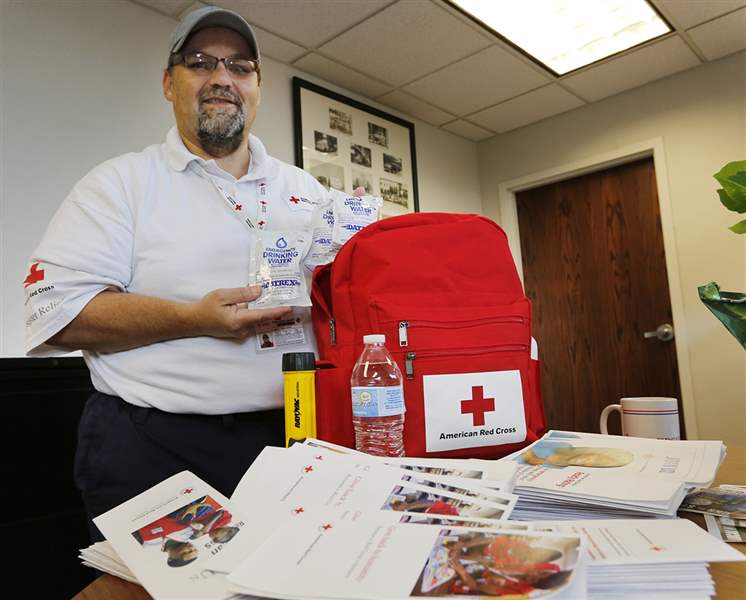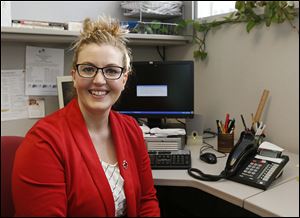
Ready for next crisis? Better get prepped
Or how to survive the zombie apocalypse
8/10/2014
‘We want to get people ready,’ says Todd James, executive director of the American Red Cross of Hancock, Seneca, and Wyandot Counties.
THE BLADE/JETTA FRASER
Buy This Image

‘We want to get people ready,’ says Todd James, executive director of the American Red Cross of Hancock, Seneca, and Wyandot Counties.
Not going to water this down.
If you bolted to buy bottled beverages last weekend, your “ready rating” is, let’s say, zero, zip.
If you scratched your head while trying to figure out how to feed your family when restaurants closed, you weren’t prepared.
If you lack skills to survive a zombie apocalypse, you are not prepared.
Preppers — those who are ready for emergencies — could take the recent Lake Erie toxic algae bloom in stride, tapping their stashes of drinking water rather than racing in their jammies to “sorry, sold out” signs at stores when Toledo’s tap water was rendered undrinkable for days.
Lesson learned?
Overall, it’s unlikely. This means the American Red Cross and other agencies will continue to pump out publications, make apps available, conduct training sessions, and try other approaches.
Amanda Aldrich, spokesman for the Northwest Ohio Region of the American Red Cross, said many area residents are not yet Red Cross Ready, and considering preparedness has been a Red Cross message for the masses for decades, disaster and emergency preparedness is an ongoing topic. The Toledo chapter, as it was known then, will mark its 100th anniversary in 2016, she noted.
As September — National Preparedness Month — approaches, the Red Cross and its community partners are getting prepped for special projects and programs.
“We want to get people ready,” said Todd James, executive director of the American Red Cross in Hancock, Seneca, and Wyandot counties, who has been assisting at the Red Cross’ Toledo office in recent days. “People see news about disasters, they see news about fires and say, ‘Wow, that is horrible,’ and they might think about getting prepared, but life gets in the way.”
Residents are lackadaisical about preparedness, Mrs. Aldrich said. They figure, she said, “It won’t happen to me.”
As thousands of area residents found out last weekend, you don’t always get time to prepare.

Aldrich
The we-gotta-do-something momentum could inspire action, and people could decide to get prepared, Mr. James said. “It does not require a lot of time or a lot of effort. Most of the items you already have in your house. When an emergency or a disaster strikes, that is not the time to run around the house trying to find what you need.”
The reality is that, depending on the disaster or emergency, you might not have time to search for a flashlight, first-aid supplies, copies of personal documents, nonperishable food, and water. The Red Cross recommends one gallon of water per person, per day, with a three-day water supply for an evacuation or for a two-week supply at home. More details are available on the American Red Cross’ Web site.
Call volume last weekend showed how unprepared people are. Thousands of area residents called the Red Cross for help. They called with questions and concerns, with fear and anxiety.
Others called to offer to help. With public interest high in volunteering, the Red Cross offered disaster volunteer training sessions Thursday. Two informational overview sessions were conducted to share basic disaster volunteerism fundamentals and recruit volunteers to assist when disasters hit.
Calls during the water crisis were handled by a variety of agencies and offices.
On Saturday, United Way 211 staff, along with 42 volunteers, answered about 3,600 calls related to water. United Way 211 is available around the clock for nonemergency requests for assistance.
Lists of residents unable to obtain water from water distribution centers were managed by American Red Cross, Meals on Wheels, and the Area Office on Aging. About 80,000 bottles of water were delivered to about 2,000 residents.
“It was inspiring to see United Way 211 staff and volunteers working tirelessly and positively during the last three days,” Eric Goff, director of community outreach for United Way of Greater Toledo, said in a statement Thursday.
For 56 hours, United Way 211 served as the number that more than 3,600 people called to find help and reassurance and someone to listen to their concerns, commented Karen Mathison, president and CEO of United Way of Greater Toledo.
Back to the zombies.
Zombies grab stuff. They grab attention. That’s exactly what the Centers for Disease Control and Prevention has in mind with its zombie-themed campaign about preparedness.
Here’s how the CDC explains it: Zombies, originally featured in a tongue-in-cheek campaign to engage new audiences with preparedness messages, have proven to have staying power.
“We continue to reach and engage a wide variety of audiences on all hazards preparedness via Zombie Preparedness,” according to the CDC Web site. The theory: If you are ready to deal with a zombie apocalypse, you will be prepared for a hurricane, pandemic, earthquake, or terrorist attack.
The CDC’s graphic novel “Preparedness 101: Zombie Pandemic” features the lives of characters Todd and Julie and their dog Max as a strange disease turns people into zombies. Spoiler alert: It’s a dream followed by a “real” severe storm that convinces the family to be prepared ... just in case.
Contact Janet Romaker at: jromaker@theblade.com or 419-724-6006.